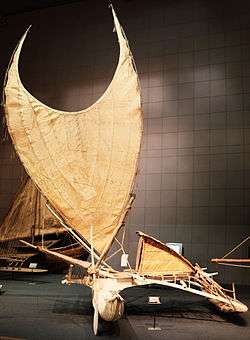Culture of the Solomon Islands
The culture of the Solomon Islands reflects the extent of the differentiation and diversity among the groups living within the Solomon Islands archipelago, which lies within Melanesia in the Pacific Ocean, with the peoples distinguished by island, language, topography, and geography. The cultural area includes the nation state of Solomon Islands and the Bougainville Island, which is a part of Papua New Guinea.[1]
The Solomon Islands includes some culturally Polynesian societies which lie outside the main region of Polynesian influence, known as the Polynesian Triangle. There are seven Polynesian outliers within the Solomon Islands: Anuta, Bellona, Ontong Java, Rennell, Sikaiana, Tikopia, and Vaeakau-Taumako.
Traditional culture

In the traditional culture of the Solomon Islands, age-old customs are handed down from one generation to the next, allegedly from the ancestral spirits themselves, to form the cultural values of Solomon Islands.
Tepukei (ocean-going outrigger canoes)

Some Polynesian societies of eastern Solomon Islands built ocean-going outrigger canoes known as Tepukei. In 1966 Gerd Koch, a German anthropologist, carried out research at Graciosa Bay on Nendö Island (Ndende/Ndeni) in the Santa Cruz Islands and on Pileni and Fenualoa in the Reef Islands, and returned with documentary film, photographic and audio material. The films that Koch completed are now held by the German National Library of Science and Technology (TIB) in Hanover.[2]
He brought back to the Ethnological Museum of Berlin the last still complete Tepukei from the Santa Cruz Islands.[3]
Contemporary culture
In the contemporary Solomon Islands, as elsewhere in Melanesia, kastom is the core of the assertion of traditional values and cultural practices in a modern context.[4] The Kastom Gaden Association,[5] for example, advocates growing and eating traditional foods rather than imported ones.[6]
Languages
Notable figures
Notable figures in contemporary Solomon Islands culture include painter Ake Lianga and musician Sharzy. Writers include John Saunana and Celo Kulagoe.[7]
See also
- Music of the Solomon Islands
- Literature of the Solomon Islands
- Languages of the Solomon Islands
- Religion in the Solomon Islands
Notes
- ↑ "Solomon Islands Profile". BBC News. Retrieved 28 May 2013.
- ↑ "IWF Wissen und Medien". Film Archives Online. Retrieved 5 February 2014.
- ↑ "Short Portrait: Gerd Koch". Interviews with German anthropologists: The History of Federal German Anthropology post 1945. 20 December 2012. Retrieved 5 February 2014.
- ↑ "The Politics of Indigenous Identity, Ethnicity and Tradition", University of Hawai'i, Center for Pacific Islands Studies
- ↑ "Gaden", not "Garden". The word belongs to the Pijin language, not English.
- ↑ "Don’t rely on import food: Kastom Gaden", Solomon Star, May 5, 2008
- ↑ "English in the South Pacific", John Lynch and France Mugler, University of the South Pacific
References
- Ross, Malcolm and Åshild Næss (2007). "An Oceanic Origin for Äiwoo, the Language of the Reef Islands?". Oceanic Linguistics. 46: 456–498. doi:10.1353/ol.2008.0003.
- François, Alexandre (2009), "The languages of Vanikoro: Three lexicons and one grammar", in Evans, Bethwyn, Discovering history through language: Papers in honour of Malcolm Ross, Pacific Linguistics 605, Canberra: Australian National University, pp. 103–126.
